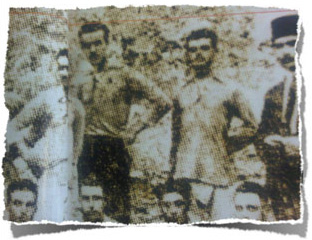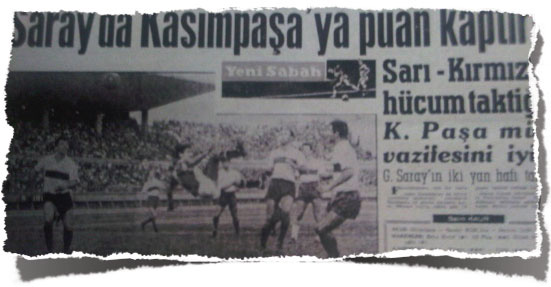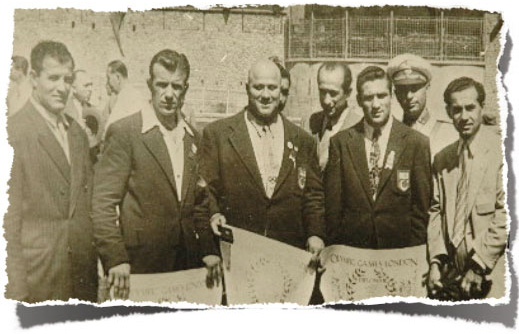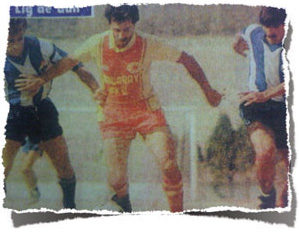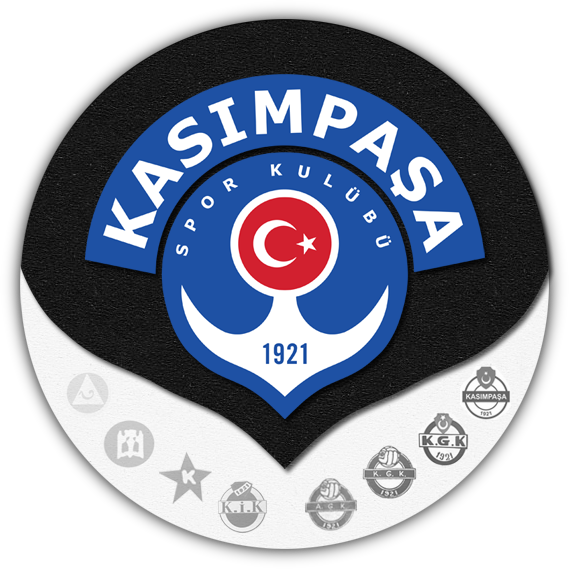
SURVEY THROUGH HISTORY
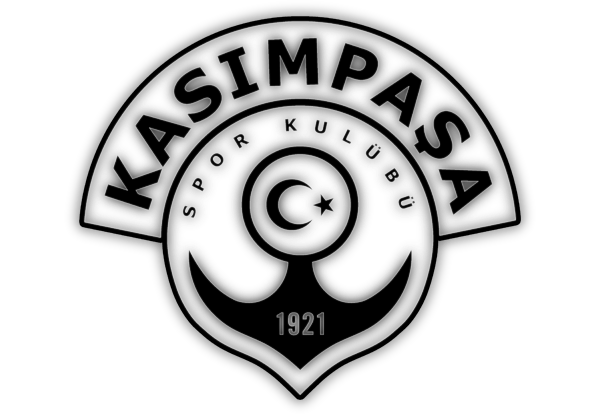
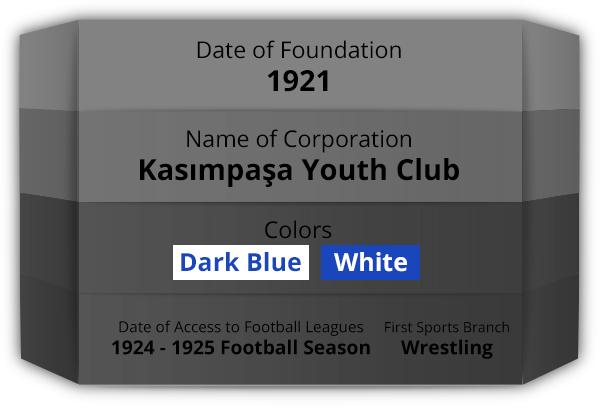
Kasımpaşa Sports Club
Our Club was awarded with the right to use the Star and Crescent in its logo by İsmet İnönü, the President of the Republic at that time, due to the successes achieved by our wrestlers Gazanfer Bilge, Mehmet Oktav and Ahmet Kireççi, who were the Champions in the World Olympics in 1948.
Upon this award, Kasımpaşa Sports Club was the second Turkish team following Beşiktaş Sports Club in Turkey, who could use the Star and Crescent in its logo.
Purpose of Establishment
To research and determine the opportunities to be engaged in all kinds of sports events and to be active in all sports branches, particularly in FOOTBALL and WRESTLING, to train the youth employing the modern sports information and to develop their personality by encouraging them to take part in any sports branch.
Turgay Ciner Sports Facilities (Club)
The new social facilities of Kasımpaşa Sports Club are situated in Kemerburgaz. It is designed as a good practice and recovery facility for the football players of Kasımpaşa as well as other players, who will contribute to Turkish football.
Address: Çatal Çeşme Sokak No.: 1 Şehit Osman Yumuk Tesisleri Yanı Kemerburgaz / Istanbul / Turkey
Phone: +90 212 360 34 38
Phone: +90 212 360 34 39
Recep Tayyip Erdoğan Stadium
Kasımpaşa Stadium was reconstructed as a multi-purpose modern sports complex in 2004 according to the criteria of UEFA and has become one of the favorite sports facilities in Istanbul and named as Recep Tayyip Erdoğan Stadium.
CONSTRUCTED WITH 7 BLOCKS
Recep Tayyip Erdoğan Stadium with a seating capacity of 14,000 with a disabled persons' stand consists of 7 blocks, i.e. blocks A, B, C, D, E, F and G. The stadium with the club building and Wrestling Section includes a back-goal stand (Guest stand) and a closed VIP stand. The stadium with a modern infrastructure was designed and constructed to provide high technology with the comfort of a 5-star hotel with its modern club building, player locker rooms, recovery rooms for players, massage saloon, snooker hall, baths and toilets.
Also, the Wrestling Section building in the complex has its own wrestling hall for our wrestlers, personal rooms for wrestlers with 5-star comfort, a gym center with all the required equipment, sauna and Turkish bath and other facilities provided for the Turkish sportsmen and athletes. Kasımpaşa Recep Tayyip Erdoğan Stadium also has a closed parking garage, which is used by the subscribed fans on match days and by the normal subscribed public on other days.
And the sports complex constructed behind the scoreboard at the left side of the marathon stand and operated by Istanbul Metropolitan Municipality includes swimming pools, enclosed basketball and volleyball fields and a fitness center.
COMPLIES WITH UEFA CRITERIA
The football field of Recep Tayyip Erdoğan Stadium was floored with aesthetic grass according to the criteria of UEFA during the construction phase and after our footballteam were promoted to the Turkcell Super League, this flooring was changed to artificial grass with the quality required for Super League matches according to the same criteria.
At Recep Tayyip Erdoğan Stadium with the field floor of 105x65m, Press A stand for 50 persons, Press B stand for 50 persons, Protocol stand with 112 seats, Guest stand with 912 seats, Disabled Person stand for 70 persons and Closed stand with 8452 seats, Panoramic Live Broadcast Room designed for TV and Radio broadcasting, Photo workshop for 100 persons, Press Room for 70 persons, and 2 TV Studios, our team achieves successes not only in the Turkcell Super League matches but also all other matches and our stadium continues to be a nightmare for our competitors.
Legends
Do you know these?
-
 1934
1934 Atatürk's Address to the Turkish Youth was read out in a ceremony and hung on the wall in the building of the Kasımpaşa Sports Club in Türabi Baba. Therefore, 1934 is an important year for both the Kasımpaşa Fans and the Kasımpaşa Practice Club.
-
 1952
1952 Kasımpaşa Sports Club became one of the first 10 clubs that opted for professional status in line with the transition of Turkish football towards professionalism in 1951. The first football match of the "Turkish Professional League" was played between Kasımpaşa and Galatasaray at the İnönü Stadium on January 5 1952.
-
 1953
1953 Necdet Çoruh from Kasımpaşa played in the National Youth Team in the "World Youth Championship" during the 1953-54 season.
-
 1954
1954 Kasımpaşa Youth Club football team was awarded for being the most sportsmanlike team during the 1954-55 season.
-
 1954
1954 Çetin Zeybek, who was a midfield player, was invited to the National Team A for the World Cup in 1954 and he was the first National Team player from Kasımpaşa.
-
 1957
1957 According to an agreement signed between Nuri Atılgan, Head of Kasımpaşa Sports Club, and the Iraq Cultural Attaché, Kasımpaşa with 22 players went to the Kingdom of Iraq on December 10 1957 and took part in a special tournament. In the tournament matches watched by King Fasial, our team lost the match with the Iraq Royal Team 2-0 and with the Iraq Military Team 4-3 and drew with the Basra team 2-2. A memorial plaque was given to Kasımpaşa fans for their visits.
-
 1958
1958 Kasımpaşa was the champion of the Third Federation Cup finals organized in Bursa in the 1958-1959 season. Kasımpaşa was accepted in the new "Turkish National League" upon this success.
-
 1960
1960 Kasımpaşa was a model club with 8 university graduate players in its team in the 1960s.
-
 1960
1960 Kasımpaşa limped out of the Cemal Gürsel Cup and played a match with Feriköy. Kasımpaşa won this match 1-0 and the goalkeeper Hazım Canıtez made a long rush when he could not see any player to pass the ball to. The ball gained speed by the effects of the storm around the Dolmabahçe Stadium and went directly into the goal of Feriköy. Goalkeeper Necdet, who was not expecting it, was shocked and Kasımpaşa scored a goal against Feriköy. Thus, Kasımpaşa, who provided many contributions to Turkish Football history, also took its place with such an "interesting goal".
-
 1961
1961 Kasımpaşa won the match with İzmir Sports Club 1-0 during the 1961-62 season to become the first Istanbul team to win a match in the Alsancak Stadium.
-
 1962
1962 Kasımpaşa and Fenerbahçe were the first teams to play the first night match on March 28 1962, the match was played in the İnönü Stadium and Kasımpaşa lost it 2-3.
Kasımpaşa District
Calm Kid of Haliç
On the northeast shore of the Golden Horn, laying from the north of Atatürk Bridge and the pools of the Golden Horn Shipyard to Hasköy on the coast; climbing the hillsides of Dolapdere to the northeast into the highlands; surrounded by Azapkapı to the south, Şişhane, Tepebaşı, Ömer Hayyam to the east, Hacıhüsrev to the north, Piyalepaşa, Okmeydanı, Aynalıkavak to the northwest… Kasımpaşa is a calm but also a wild Kid of Haliç within the borders of Beyoğlu.
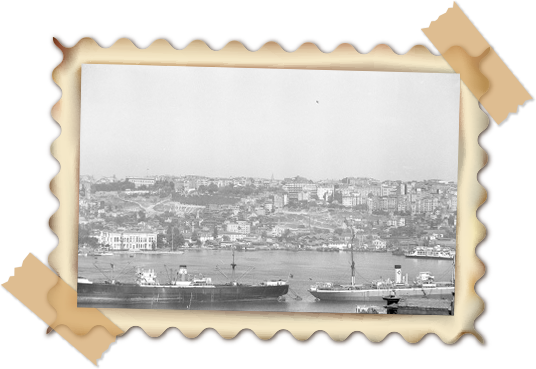
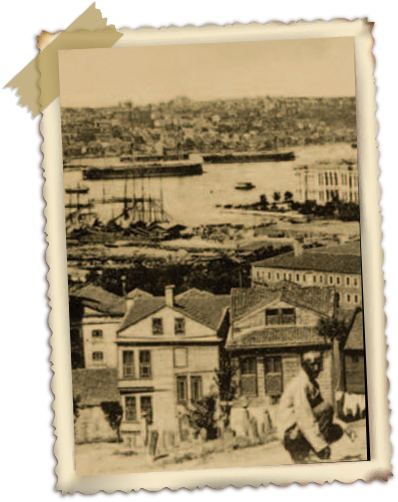
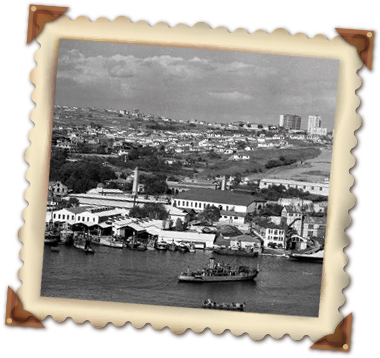
Current quarters of the district are Cami-i Kebir, Kadı Mehmed Efendi, Sururi Mehmed Efendi, Yahya Kahya, Fetihtepe, Küçük Piyale, Piyale Paşa, Bedrettin, Çatma Mescit, Hacı Hüsrev, Kulaksız and Kaptan Paşa. According to the census in 1997, the total population of the “Kasımpaşa District” is about 100,000.
Kasımpaşa and its vicinity were known as Pegai (sources) during the Byzantine period. It was known as Pegai Psihra Hidata (cold waters) in the later literature. As can be understood from such names, there are many waters, sources and creeks in the district. It is known that Basileos I had one summer palace and four chapels constructed in Pegai. It is reported in the literature that the palace survived until 921 and then it was ruined during the encompassment of Bulgaria when Byzantine armies were defeated and then repaired after some time. It is estimated that the palace was located on a high hill on the coast of Kasımpaşa. There was no settlement area in the district during the Byzantine period, but it was used as a recreation area. Upon the arrival of Muslims, Islam was widely embraced.
Kasımpaşa was a monastery in old times and known as “ayalonka” by the non-Muslims according to the journals of Evliya Çelebi. After the Conquest of Istanbul, it was used as a Muslim Cemetery upon an imperial order. Also this area behind the shipyard in Kasımpaşa had been used as a cemetery as ordered by Mesleke and Eba Eyyub Ensari during the caliph Abdülmümin Melik’s period and then during the conquest of some part of Istanbul and a half of Galata by Harun Reşid and Yıldırım Bayezid. It is known that Sahabe-i Kiram and his esteemed sons were buried here. There are some signs written on Cufic stones in the cemeteries.
The Ottoman settlement in Kasımpaşa began with the conquest of Fatih. When the Turks arrived, this area was a vacant field outside the walls of Galata. Fatih The Conqueror had the first bridge constructed on the opposite shore of the Golden Horn after reaching the Golden Horn with his warships through Kasımpaşa (Kozluca) creek, which has now disappeared. In addition, according to Evliya Çelebi, “he had the cemeteries repaired, had a few small shipyards, Captain Pasha Ottoman’s house and one mosque constructed.” Istanbul shipyard, which would then be known as the Golden Horn shipyard, was constructed here and sailors from Lazistan and Karaman were brought in. According to Sadi Abaç, the original community living in Kasımpaşa are from İzmir and Gallipoli, although there were many sailors from Lazistan and Karaman. After the Conquest, the Golden Horn coast of Kasımpaşa had been a sailor’s settlement area as it is today. In 1516, the Gallipoli shipyard was also moved to Kasımpaşa.
This area was first known as Kasımpaşa during the period of Suleyman The Magnificent. Evliya Çelebi, who was also born in Kasımpaşa, tells this story as follows: “During the period of Suleyman The Magnificent, when the population of Istanbul became very crowded, an imperial order was released to assign Vizier Kasım Pasha, the conqueror of Ayabolu, and Vizier Ayas Pasha, the conqueror of Alaüddevle as the officers responsible for the construction of the Kasımpaşa district. With the support of thousands of Ottoman notables, Kasımpaşa district was properly built up”. After such construction activities, the area took its name from Vizier Kasım Pasha, who constructed a Mosque and various buildings.
Kasım Pasha was raised in the palace and was first assigned to a position outside the palace as the Stirrup Aga. Kasım Pasha, who had also twice worked as Governor of Egypt, was assigned to the construction of Kasımpaşa during the period of Suleyman The Magnificent. Kasım Pasha, who is supposed to be a Chief Admiral, could not be a Chief Admiral, even if he had been awarded with plumes.
According to Schweigger, an itinerant, who visited Istanbul during the period of Suleyman The Magnificent, there were many slaves in Kasımpaşa and around the shipyard. According to this rumor, 12,000 slaves of Piyale Pasha were living in Kasımpaşa and most of them were employed in the shipyard. Schweigger reports that such slaves were living in comfort in this area, they were allowed to go to the public bath once a week and to worship in St. Pierre Fransisken Church in Galata on Sundays and they even had days off during holidays. But the protestant slaves were worshipping in the ships of the protestant states, since there was no protestant church in Istanbul.
It is also written by Evliya Çelebi, the famous Ottoman itinerant, that the rulers of Kasımpaşa were the Galata Kadi according to Muslim canonical laws as well as Captain Pasha, the shipyard chamberlain and head officers according to state laws. Kasımpaşa had been the most prosperous and important districts of Istanbul in the 17thcentury. There are about ten thousand houses in Kasımpaşa according to the census in the period of Murat IV and the population was classified into three groups, i.e. as soldiers, tradesmen and merchants, and dervishes. Evliya Çelebi gives the distribution of craftsmen in the district as follows: He reports that calking masters and raft constructers from Benghazi and Egypt settled in Zindanarkası, forger Armenians in the Yeniçeşme Armenian Quarter, and iron forger and ring producer gypsies in Çürüklük and the upper areas. Robert Mantran also indicates that the most significant characters living in Kasımpaşa in that century were tradesmen and craftsmen. Such tradesmen and craftsmen were generally from tanner, gardener, carpenter and sailor communities. In addition to them, according to the itinerary, there were many brethren and dervishes in Kasımpaşa district. There were almost twenty dervish lodges in the district, including kadiri, rufai, halveti, celveti, uşşaki, and mevlevi lodges etc.
Evliya, of course, did not forget the women of the district. He used the expressions of “very mannerly and chaste.” According to him; “There are many lovely ladies and gentlemen in Kasımpaşa,” because, the “weather of Kasımpaşa is very pleasant.” According to Mehmet Halil Bayrı, author of the book entitled Istanbul, the reason of Evliya’s praising the women of Kasımpaşa may be the fact that “he saw a gorgeous and eye-catching lady at every step.


